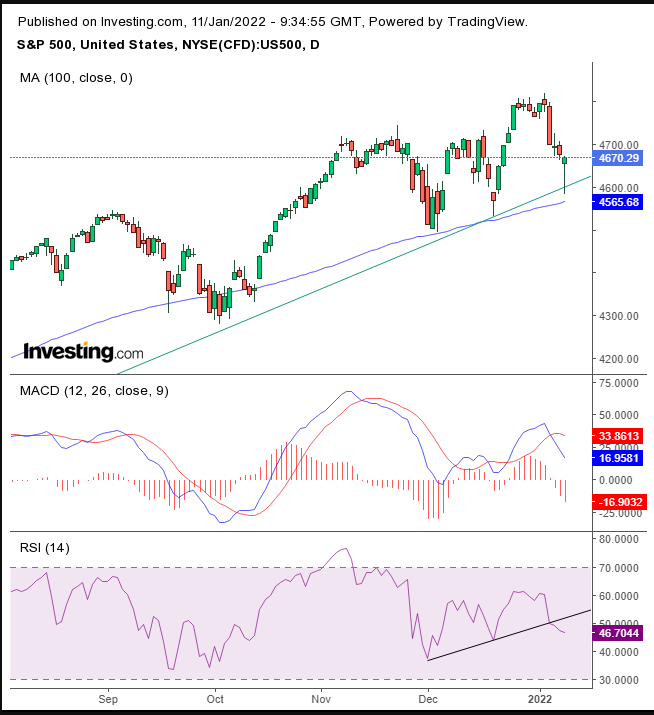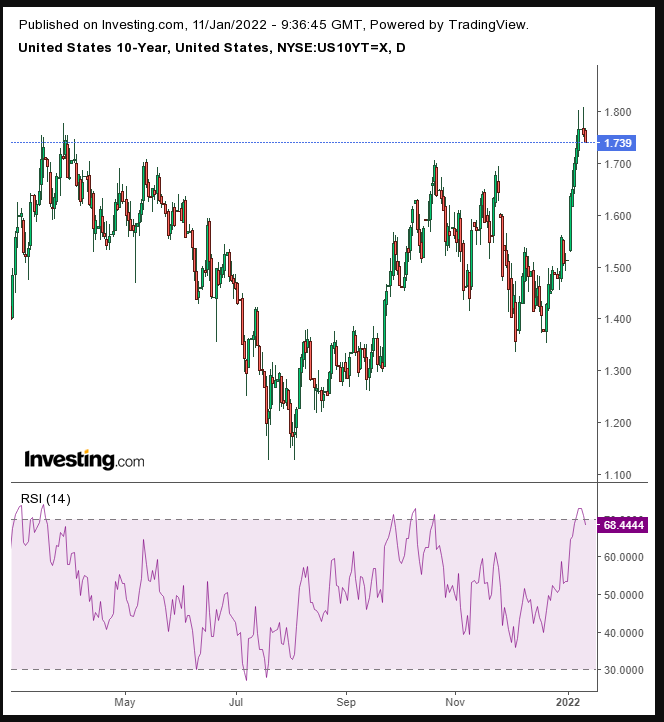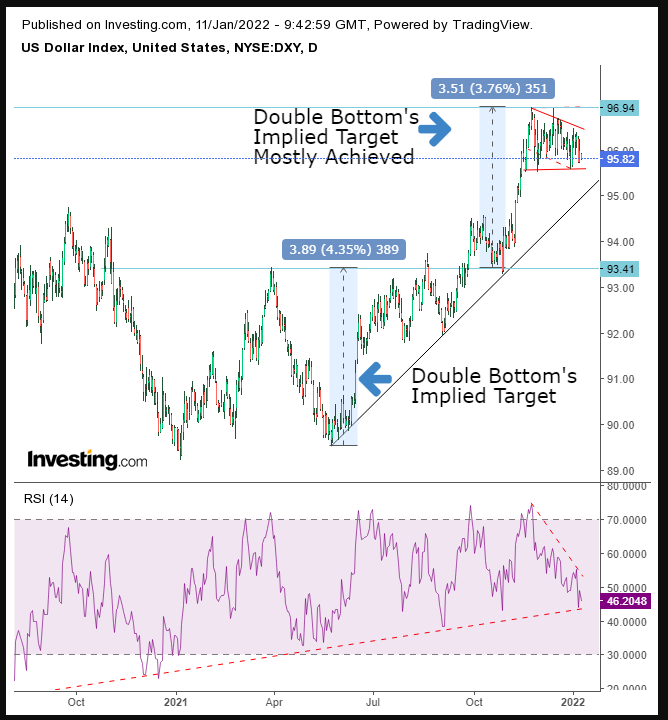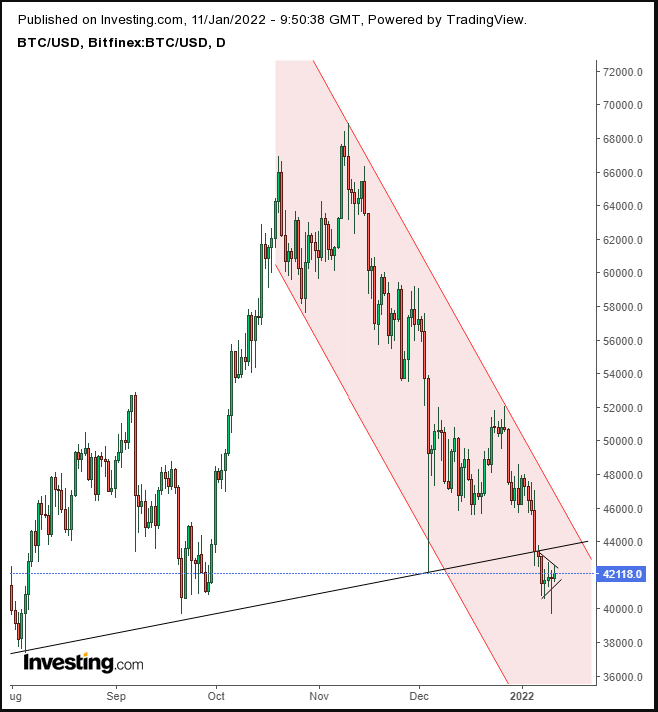- Falling yields encouraged tech dip-buying
- Typical equity-yield correlations may not be significant now
- Omicron might be peaking in New York, prompting risk appetite
Key Events
After a selloff in Asia, futures on the Dow Jones, S&P 500, NASDAQ and Russell 2000 recovered in trading on Tuesday. Now, traders are keenly awaiting today's testimony from Federal Reserve Chairman, Jerome Powell—scheduled for mid-morning US time—at the Senate Confirmation hearing for his second term. The expectation is the central bank head might provide some indication on upcoming interest rate hikes.
Yields, which had rallied strongly in recent days, weakened.
Global Financial Affairs
All four US contracts were in the green, all between +0.2% and +0.6%. In Europe, the STOXX 600 Index gained over 1% as traders bought the steepest dip in six weeks after the pan-European gauge dropped 1.5% on Monday. The STOXX Technology sub-index, which led Monday's selloff, jumped 2.2% this morning.
The market narrative claims that rising US Treasury yields prompted a sharp decline in equities. Typically, that makes sense, as yields and stocks possess a negative correlation. However, that occurs when investors rotate between risk and haven assets.
This time, however, both stocks and bonds sold off in unison as the market expects higher interest rates, which may not be good for many overvalued equities. Still, some stocks on Wall Street, including mega cap techs, rallied yesterday, with the NASDAQ even finishing marginally higher on an otherwise down day. The narrative says it was investors taking advantage of the recent tumble in growth shares to bag a bargain.
This morning, all the major Asian benchmarks closed lower. A glimmer of light was visible in South Korea, where the KOSPI gained 0.02%. A jump in case numbers in China was deemed the culprit for a 0.73% decline in Shanghai, but the 0.77% slide in Australia's ASX 200 was driven by the retail sector as the number of COVID cases there neared record levels.
On Monday, the S&P 500 closed lower for the fifth straight day.

The price formed a bullish hammer supporting the index's uptrend line, reinforced by the 100 DMA. However, both the RSI and the MACD provided bearish crosses.
The NASDAQ 100 eked out a 0.14% gain. The tech-heavy gauge rebounded from losses with mega-cap players, like Apple (NASDAQ:AAPL) and Microsoft (NASDAQ:MSFT) dropping as much as 8.5% from November records during the session. Both recovered and closed in the green, albeit only just.
Tightening policy from the Fed tends to hit overvalued shares. Goldman Sachs forecasts that the Fed will raise rates four times this year and begin shrinking its balance sheet in July, if not earlier.
Investors are waiting for Wednesday's critical inflation data, which could increase pressure on the Federal Reserve to tighten policy further. The bounce came at the same time that signs indicated Omicron may be peaking in New York, with cases and emergency room visits in decline.
Treasury yields on the 10-year note also eased.

Yields extended Monday's decline, which formed a bearish shooting star on the resistance of the March peak. Also, the RSI curved down from an overbought condition.
The dollar edged lower, paring yesterday's slight advance, as the greenback resumes a sideways move since Nov. 24, when the US currency reached the highest level since July 2020.

We have been going back and forth on the kind of pattern developing, but at this point, it's likely best to wait for a decisive breakout, which could be violent. We're betting that the dollar will turn higher when nearing its uptrend line. Something drastic will have to happen for the dollar not to rally when the Fed tightens policy. The RSI also seems to be heading toward a resolution.
Gold rose for the third day, coming up against the resistance of its previous uptrend line since the Dec. 15 low.

While the RSI peaked out from its most overbought state since Dec. 17, we're betting the precious metal will fall back down, testing its Jan. 6 low. That would also agree with the fundamental environment of a stronger dollar and higher rates.
Bitcoin moved sideways for the fourth day in what we predict is a bearish pennant after completing a massive H&S top, whose implied target aims at the $30,000 level.

If that breaks, according to the principles of technical analysis, the leading digital coin could fall to multi-year lows.
Oil gained ahead of US inventories data due for release tomorrow, erasing a two-day slide as the black gold edges toward $80 and is at the highest levels since Nov. 16.
Up Ahead
- The US Beige Book is printed on Wednesday.
- On Thursday, US initial jobless claims are released.
- US PPI figures are published on Thursday.
Market Moves
Stocks
- Futures on the S&P 500 rose 0.2%
- Futures on the NASDAQ 100 were little changed
- Futures on the Dow Jones Industrial Average rose 0.2%
- The MSCI Asia Pacific Index rose 0.1%
- The MSCI Emerging Markets Index rose 0.5%
Currencies
- The Dollar Index fell 0.1%
- The euro rose 0.2% to $1.1347
- The Japanese yen rose 0.15% to 115.38 per dollar
- The offshore yuan flat at 6.3788 per dollar
- The British pound rose 0.16% to $1.3597
Bonds
- The yield on 10-year Treasuries rested at 1.75%
- Germany's 10-year yield was little changed at -0.04%
- Britain's 10-year yield declined one basis point to 1.18%
Commodities
- WTI crude climbed 1.66% to $82.09
- Brent crude rose 1.67% to $81.68 a barrel
- Spot gold rose 0.4% to $1,808.71 an ounce
